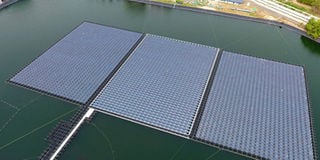First solar hydro hybrid plant paused

A solar hydro hybrid plant. Uganda has shelved its plan to construct a solar hydro hybrid plant. courtesy photo
What you need to know:
Financial, environmental and social viability did not make it possible to set up the solar hydro hybrid dam, Christine Kasemiire writes.
Uganda will have to wait a while longer before it can see its first solar hydro hybrid power plant.
This follows a halt on plans to establish solar on the 6.6 megawatt Nyagak III dam in West Nile.
According to Uganda Electricity Generation Company Limited, government had last year embarked on feasibility studies to ascertain the viability of a solar hydro hybrid plant.
“During the year, in collaboration with our Norwegian Partners, Malthe Winje Infrapower (MWIP) and Giertsen Energy Solutions, we were able to embark on a Solar Hydro Hybrid Feasibility Study on the Nyagak III,” the generator noted in its 2019 report.
The study, the report says, was a precursor to the development of the first hybrid energy generation project in Uganda.
However, Mr Simon Kasyate, head of communications and corporate affairs at UEGCL told Daily Monitor last week that studies were concluded and it was resolved to shelve the hybrid plan.
“Studies were carried out and at the moment, we do not think it makes dollar sense to do so and it was not meeting viability for many other reasons. So at the moment, Nyagak is being developed as an explicitly hydropower project,” he explains.
Not viable
Government paused plans for the hybrid over the placement of solar panels. UEGCL had earlier on envisaged that the solar panels would sit on the reservoir but it was challenging.
“We were asking ourselves where we are going to put the solar panels. Earlier thinking was that we would put them on the reservoir created; in other words, the lake behind. But we were looking at the concerns such as security and the environment,” he says pondering on the existential threat the project would cause to animal life underwater.
Kasyate further explains, a large chunk of land would be needed which would require a lot of money.
Consequently, financial, environmental and social viability did not make it possible to set up the hybrid dam.
UEGCL stressed that the idea is not cremated but rather paused to first address lack of electricity in West Nile region that will be solved by the hydro dam.
The solar back up was meant to absorb the shocks created by the ‘not so secret’ effects of climate that cause unpredictable weather conditions.
UEGCL insists that there is still a possibility that the plan to transform the hydro into hybrid will one day come to life. This is because the generator is searching for alternative water resources other than River Nile on which to sit hydro dams.
UEGCL is considering other energy resources to boost the energy mix such that the country has not only abundant but also reliable electricity generation.
Currently, the country’s electricity generation capacity is 1,254MW with peak demand of about 670MW.
Meanwhile, UEGCL plans to bring on board 48MW Muzizi hydropower plant that is awaiting German bank, KfW’s no objection to proceed and award the contract to the contractor.
Elsewhere
While a new venture in Uganda, solar hydropower hybrids have been set up, elsewhere a study by the international hydropower association reveals that in December 2013, after nine months of construction, the Gonghe PV solar park was commissioned and connected to the power grid via the nearby Longyangxia hydropower plant on the Yellow River in China.
Issues
One of the concerns raised by activists, however, is the environmental degradation inflicted on water resources by large scale investments.
According to MS Diana Nabiruma, senior communications officer, Africa Institute for Energy Governance (AFIEGO) dams have been seen to be unfavourable to water resources and life underwater.
“One of the things we have raised in the past is that when you put a dam in a place, you tend to destroy economic activities that exist in that area such as fishing. You also destroy breeding grounds and habitats for some living things,” she notes highlighting that for limited species, these investments could lead to extinction.




